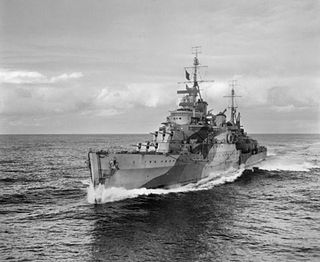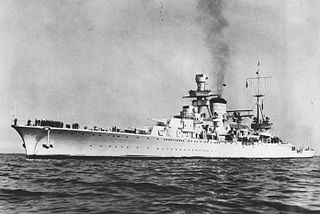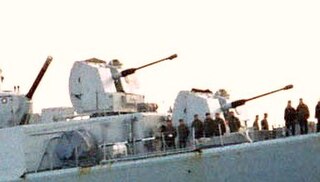
The heavy cruiser was a type of cruiser, a naval warship designed for long range and high speed, armed generally with naval guns of roughly 203 mm (8 inches) in calibre, whose design parameters were dictated by the Washington Naval Treaty of 1922 and the London Naval Treaty of 1930. The heavy cruiser is part of a lineage of ship design from 1915 through the early 1950s, although the term "heavy cruiser" only came into formal use in 1930. The heavy cruiser's immediate precursors were the light cruiser designs of the 1900s and 1910s, rather than the armoured cruisers of the years before 1905. When the armoured cruiser was supplanted by the battlecruiser, an intermediate ship type between this and the light cruiser was found to be needed—one larger and more powerful than the light cruisers of a potential enemy but not as large and expensive as the battlecruiser so as to be built in sufficient numbers to protect merchant ships and serve in a number of combat theatres.

The Town class consisted of 10 light cruisers built for the Royal Navy during the 1930s. The Towns were designed to the constraints imposed by the London Naval Treaty of 1930. The ships were built in three distinct sub-classes, the Southampton, Gloucester and Edinburgh classes respectively, each sub-class adding on further weaponry.

The County class was a class of heavy cruisers built for the Royal Navy in the years between the First and Second World Wars. They were the first post-war cruisers constructed for the Royal Navy and were designed within the limits of the Washington Naval Treaty of 1922. Such ships, with a limit of 10,000 tons, standard displacement and 8-inch calibre main guns may be referred to as "treaty cruisers".

The York class was the second and final class of heavy cruisers built for the Royal Navy under the terms of the 1922 Washington Naval Treaty. They were essentially a reduced version of the preceding County class, scaled down to enable more cruisers to be built from the limited defence budgets of the late 1920s.

The Trento class was a group of two heavy cruisers built for the Italian Regia Marina in the late 1920s, the first such vessels built for the Italian fleet. The two ships in the class—Trento and Trieste, were named after the redeemed cities of Trento and Trieste annexed from the Austro-Hungarian empire after the victory in World War I. The ships were very lightly armored, with only a 70 mm (2.8 in) thick armored belt, though they possessed a high speed and heavy main battery of eight 203 mm (8 in) guns. Nominally built under the restrictions of the Washington Naval Treaty, the two cruisers nevertheless exceeded the displacement limits imposed by the treaty.

Pre-dreadnought battleships were sea-going battleships built between the mid- to late- 1880s and 1905, before the launch of HMS Dreadnought in 1906. The pre-dreadnought ships replaced the ironclad battleships of the 1870s and 1880s. Built from steel, protected by case-hardened steel armour, and powered by coal-fired triple-expansion steam engines, pre-dreadnought battleships carried a main battery of very heavy guns in fully enclosed rotating turrets supported by one or more secondary batteries of lighter weapons.

Almirante Brown was a Veinticinco de Mayo-class heavy cruiser in service with the Argentine Navy. The ship was named in honour of Admiral Guillermo Brown, the Father of the Argentine Navy.

ARA Veinticinco de Mayo was a cruiser which served in the Argentine Navy. The English translation of the name is May 25, which is the date of Argentina's May Revolution in 1810.

The Dunkerque class was a pair of fast battleships built for the French Navy in the 1930s; the two ships were Dunkerque and Strasbourg. They were the first French battleships built since the Bretagne class of pre-World War I vintage, and they were heavily influenced by the Washington Treaty system that limited naval construction in the 1920s and 1930s. French battleship studies initially focused on countering fast Italian heavy cruisers, leading to early designs for small, relatively lightly protected capital ships. But the advent of the powerful German Deutschland-class cruisers proved to be more threatening to French interests, prompting the need for larger and more heavily armed and armoured vessels. The final design, completed by 1932, produced a small battleship armed with eight 330 mm (13 in) guns that were concentrated in two quadruple gun turrets forward, with armour sufficient to defeat the Deutschlands' 283 mm (11.1 in) guns. Strasbourg was completed to a slightly modified design, receiving somewhat heavier armour in response to new Italian Littorio-class battleships. Smaller and less heavily armed and armoured than all other treaty battleships, the Dunkerques have sometimes been referred to as battlecruisers.

The La Galissonnière-class cruisers were commissioned by the French Navy in the 1930s. They were the last French cruisers completed after 1935, until the completion of De Grasse in 1956. They are considered fast, reliable and successful light cruisers. Two cruisers of this class, Georges Leygues and Montcalm, took part in the defence of Dakar in late September 1940 during World War II. With the cruiser Gloire, they joined the Allied forces after the successful Allied landings in North Africa in November 1942. The three other cruisers of the La Galissonière class, held under Vichy control at Toulon, were scuttled on 27 November 1942.

The Aoba-class cruisers were a class of two heavy cruisers constructed for the Imperial Japanese Navy (IJN) which saw service during World War II.

The Myōkō-class cruisers were a series of four heavy cruisers built for the Imperial Japanese Navy in the late 1920s. Three were lost during World War II.

The QF 5.25-inch Mark I gun was the heaviest dual-purpose gun used by the Royal Navy during the Second World War. Although considered less than completely successful, it saw extensive service. 267 guns were built.

The Giuseppe Garibaldi-class cruisers were a class of ten armoured cruisers built in Italy in the 1890s and the first decade of the 20th century. The ships were built for both the Royal Italian Navy and for export. With the class being named for Italian unifier and nationalist Giuseppe Garibaldi.

The BL 8 inch gun Mark VIII was the main battery gun used on the Royal Navy's County-class cruisers, in compliance with the Washington Naval Treaty of 1922. This treaty allowed ships of not more than 10,000 tons standard displacement and with guns no larger than 8 inches (203 mm) to be excluded from total tonnage limitations on a nation's capital ships. The 10,000 ton limit was a major factor in design decisions such as turrets and gun mountings. A similar gun formed the main battery of Spanish Canarias-class cruisers. In 1930, the Royal Navy adopted the BL 6 inch Mk XXIII naval gun as the standard cruiser main battery in preference to this 8-inch gun.

The 76mm/L62 Allargato is a single barrel, medium caliber, dual purpose automatic naval cannon designed and produced in the 1960s by the Italian defence firm of OTO-Melara as the cannon armament for all medium and large warships built for the Italian Navy in that decade. Currently, the gun remains in service with Italy's Cassiopea-class patrol vessels but has otherwise been largely replaced by the Otobreda 76 mm series of cannons.

Nueve de Julio was a protected cruiser of the Argentine Navy. The ship was acquired by the Argentine navy as part of the South American naval arms race in the 1890s. Completed in 1893, the vessel remained in service until 1930.

ARA Veinticinco de Mayo was a protected cruiser that served in the Argentine Navy between 1891 and 1921.
The Neptune class was a proposed class of cruisers planned for the British Royal Navy in the latter years of the Second World War. They were large ships which were to be armed with twelve 6-inch (152 mm) dual-purpose guns and with a heavy secondary armament. Although five ships of the class were planned in 1944, they were cancelled following the end of the war, before construction could begin.

The EOC 8 inch 45 caliber were a family of related 8-inch (203 mm) 45 caliber naval guns designed by the Elswick Ordnance Company and manufactured by Armstrong for export customers before World War I. In addition to being produced in the United Kingdom licensed variants were produced in Italy and in Japan. Users of this family of gun included the navies of Argentina, Chile, China, Italy, Japan and Spain. This family of guns saw action in the Spanish–American War, Boxer Rebellion, Russo-Japanese War, Italo-Turkish War, World War I and World War II. In addition to its naval role it was later used as coastal artillery and siege artillery after the ships it served on were decommissioned.



















